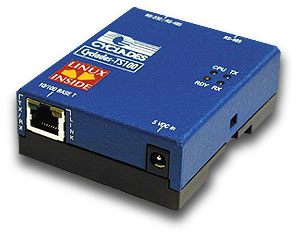Article: Device Profile: Cyclades TS100 ‘device server’
May 3, 2002 — by LinuxDevices Staff — from the LinuxDevices Archive — 15 viewsCyclades Corp., a provider of Linux-based networking solutions, recently announced its newest product: the Cyclades-TS100. The TS100 is a powerful yet highly compact device server which is used to connect various serial devices to a TCP/IP network. Typical applications include industrial automation and control, out-of-band network management, retail automation, and connecting various types of… serially-interfaced devices to networks.
The TS100 has interface ports for both 10/100 Mbit/sec Ethernet and RS232/RS485 serial lines, allowing it to integrate legacy instruments and systems having serial interfaces to broadband networks using TCP/IP protocols. The device supports SSHv2 (Secure Shell), thereby providing a high degree of security. Furthermore, unlike competing device servers which are based on proprietary embedded software, the TS100's built-in Embedded Linux operating system and other open source software give its users the flexibility and power to customize its operation, modifying or adding features as needed.

What's inside the TS100?
Although not much larger than a deck of playing cards — at 2.8 x 3.4 x 1.2 in. — the TS100 contains not just one, but two microprocessors. This is possible thanks to the use of Motorola's MPC855T “PowerQUICC Integrated Communications Processor”. The MPC855T is a dual-core system-on-chip processor that includes a 32-bit MPC8xx PowerPC core processor (running at 50 MHz) plus a separate RISC engine specifically designed to offload communication tasks. Memory resources consist of 16MB of SDRAM, plus a 4MB Flash disk from which the firmware is uncompressed and loaded into a ramdisk at boot time.
The device's embedded operating system is based on Linux kernel 2.2.14, along with a variety of open source utilities including the GoAhead webserver (for the Web Management Interface), Portslave, OpenSSH 3.1, crontab, Busybox, nettools, rsyncm, and others. Cylades started from MontaVista's Hard Hat Linux 1.2, doing their own in-house customization. Most of the software had to be heavily modified to make it run optimally on the TS100's resources.
Development challenges
“The biggest challenge for Embedded Linux development is to become familiar with the Linux kernel structure in order to feel confident to change it,” said Cyclades VP of Engineering is Marcio Saito. “This was a challenge we had already undertaken with Linux in the past, so it was pretty straightforward to work with Embedded Linux.”
“Furthermore, as the MontaVista Hard Hat Linux package already had a lot of work done for the PowerPC architecture, all we needed to do at the kernel level was to adapt some of the drivers to our hardware specifics and integrate our boot code,” continued Saito. “Other than that, the hard work was in modifying and enhancing 'user space' applications for the specific requirements of our embedded system — in this case, implementing the functions of a console access server and device server.”
Why use Embedded Linux?
“We chose Linux because we have a long history with it, having started using and supporting Linux in 1994, when we were the first hardware company to officially support Linux drivers for multiport serial cards,” Saito said. “As we were already very familiar with the Linux kernel and its flexibility as an operating system, we decided to use it on our embedded products as well.”
“We got the software at an already advanced state and improved it,” explained Saito. “As our changes are also Open Source, someone else can get the software at its current state and improve it more, while we also continue to improve it. In this model, the software can only get better and better, and we all benefit from it in terms of reliability, performance, dependability, etc. That's the beauty of an Open Source solution.”
“All the changes made and new features implemented are Open Source, as we believe in this philosophy,” Saito added. “In fact, we provide a Cyclades Development Kit (CDK), free of charge to our customers, with which they can customize the system image of the TS100 to add or remove functionality, port their applications, etc.”
What does Saito see for the future of Embedded Linux? “Linux is not even the future anymore, it is already the present of the embedded market, and it's here to stay. Just have a look at the embedded system tradeshows and you'll see what I mean,” he concluded.
Pricing and availability
The Cyclades-TS100 is priced at $299 and has been in volume production since January 2002.
This article was originally published on LinuxDevices.com and has been donated to the open source community by QuinStreet Inc. Please visit LinuxToday.com for up-to-date news and articles about Linux and open source.